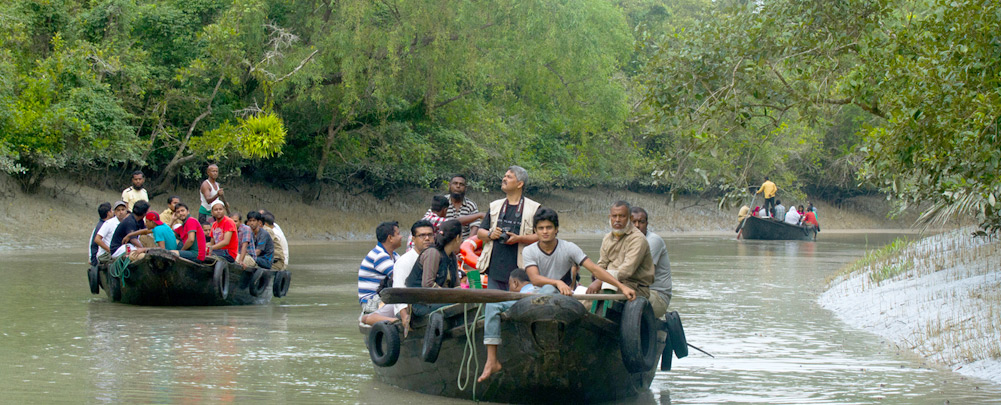The Sundarbans Delta: A Brief Introduction
The Sundarbans Forest is named after the famous “Sundaduri” trees. It is home to a diverse population of exotic birds, animals, sea animals, tribes, and cultures. Moreover, the Sundarbans are the world’s largest mangroves.
The Sunderbans Delta is located on the border of India and Bangladesh, in the Ganges and Brahmaputra River deltas. The Sundarbans Forest area spans 10,277 km² in total.
Owing to its unique and rich environment, UNESCO declared the Sundarbans a World Heritage Site in 1987.
The Sunderbans are famous for:
- It is home to the Royal Bengal Tiger.
- It is the world’s largest mangrove.
- Varieties of exotic birds migrate to Sunderbans during the winter.
- The flora and fauna have unique characteristics.
- It is a fishery board.
- The forests have interconnected waterways.
- Unique and diverse local cultures and traditions.
- These mangroves are a UNESCO World Heritage Site.
Popular Destinations You Must Visit in The Sundarbans
Whether you ride a bicycle around a village or tour the mangroves on a boat, it’s never enough. Wildlife spotting, bird watching, and mangrove exploration will keep you busy all day. Stay up at night for the thrilling night safari. It is heaven on earth for all nature lovers.
Sajnekhali Watchtower
The Sajnekhali watchtower is a piece of heaven on Earth for bird lovers. The watchtower hosts a diverse population of birds, especially during winter.
If you’re lucky enough, you can spot exotic birds such as mangrove pitta, masked finfoot, mangrove whistler, and black-capped kingfisher, among various others.
A maximum of 20 people can stay there at once, and it is situated close to Sundarbans National Park.
Kalash Island
Kalash Camp lies in the Chulkathi-1 Block of the South 24 divisional forest of the Sundarbans. The Kalash Island beach is located at the estuary of the River Matla.
Though tourists and adventurers are not allowed to visit the beach, it is still a beautiful place for watching birds and enjoying the view.
People visiting in the winter have a high chance of seeing the Olive Ridley Turtles that arrive in great numbers on this beach for nesting.
Netidhopani
Netidhopani is a site where history and traditions meet. The main attraction includes a 400-year-old temple. Netidhopani is associated with the legends of Behula and Lakhindari.
You can also visit the watchtower to spot birds. This watch tower can host 20 people at a time.
Sudhanyakhali Watchtower
The Sudhanyakhali watchtower is the best place to spot the Royal Bengal Tiger. You can also spot axis deer, monitor lizards, wild boars, and crocodiles.
This watch tower has a capacity to host 25 people at a time. The watch tower is a popular tourist location.
Bhagatpur Crocodile Project
Bhagatpur Crocodile Project is a large crocodile estuarine. This place is the hatchery of the Batagur Baska species of tortoise.
Burirdabri Watch Tower
The Burirdabri watch tower is well-known for its mudwalk and mangrove cage. The place offers a scenic viewpoint. There are also vistas from Bangladesh’s Raymongal side. This watch tower can hold 15 people at a time.
Offbeat Tourist Spots Near the Sundarbans
The following destinations are close to Kolkata and remotely populated. Tourists often miss out on visiting these islands; this makes these islands perfect offbeat destinations to visit.
Let’s get started!
Henry Island
Henry Island is situated near the village of Bakkhali. The island is named after a British explorer. This destination is known for its beautiful beach.
You can have a fun time at the beach, explore the mangroves, or relax and watch birds. The waters are calm and the environment in and around the island is peaceful.
You must visit Henry Island if you want to get away from the noise and pollution of the city.
Lothian Island
This island is a piece of heaven on earth for adventurers and explorers. The island hosts many exotic birds, animals, and sea animals, including the Olive Ridley Sea turtle, spotted deer, rhesus macaques, jungle cats, estuarine crocodiles, and birds like the Paradise Flycatcher, Black-Capped Kingfisher, Curlew, White-Bellied Sea Eagle, Tern and Whimbrel.
Due to its location, it falls under the risk of cyclones and floods. So, it’s better to travel during the winter.
Piyali Island
Piyali Island is situated only 75 km away from Kolkata. This island is situated between the Malta River and the Piyali River.
The best time to visit Piyali Island is between the cooler months of November and February. During this time, the weather will be good, with little or no rain. It’s ideal for observing animals and exploring the thick mangroves.
The Best Time to Visit
The best time to visit the Sundarbans is during the winter season. The reasons are:
- Enjoyable Climatic Conditions: The forests of Sunderbans come to life during the winter. You can enjoy boat safaris and trips to local villages. The humidity is moderate, and the average temperature fluctuates between 10 (at night) and 30 (during the day) degrees Celsius.
- The Best Time for Birdwatching: There are about 248 bird species found in Sunderban national park. Many exotic birds migrate to the mangrove during the winter months. You must visit the Sajnekhali Bird Sanctuary, Dobanki Watchtower, and Sudhanyakhali Watchtower. You can spot birds such as sandpipers, plovers, Northern Pintail White-bellied Sea eagles, ospreys, etc.
- Calmer and safer waterways: The entire Sundarbans delta is interconnected by rivers and streams. The water levels rise during the monsoons and the flow of water becomes too strong. Compared to the monsoon months, travel is easier and safer in winter.
- Snakes and insects Stay in Hibernation: The Sundarbans Delta is home to a variety of venomous snakes and insects. Snakes like King Cobra, Common Cobra, and Russell’s Viper are easily spotted during the summers and the monsoons. You can avoid any unplanned and dangerous meetings with snakes and insects if you are visiting between November and February.
- Local Fairs: Many tribal communities organize melas in December and January. The two biggest fairs (melas) arranged during the winter are the Bonbibi Mela and the Poush Mela.
Different Ways of Reaching the Sundarbans
Reaching the Sundarbans delta is not a hard task. It is only around 100-130 km away from Kolkata.
By Rail: The nearest railway station is Canning, which is approximately 48 kilometers from the Sundarbans.
From Kolkata, you must board a local train (EMU) from Sealdah (South) to Canning. Then take a bus or traveler from the station to your resort or hotel.
By Road: Buses to Sonakhali and Godkhali are available from Esplanade, Kolkata. You can hire a private taxi or cab to reach Godkhali directly from Kolkata. Then take a boat or launch for the Sundarbans.
By Air: The nearest airport is Netaji Subhash Chandra Bose International Airport at Dumdum, Kolkata, which is 112 km away from the mangroves.
After arriving in Kolkata, you need to take the road or train route to reach the Sundarbans.
The journey from Kolkata to the Sundarbans can take around 3-4 hours, including the boat ride.
To Wrap Up
The Sundarbans Delta is a truly unique and mesmerizing destination that offers a rare combination of natural beauty, rich biodiversity, and cultural heritage.
Whether you’re an adventurer looking for thrilling wildlife experiences, a nature lover seeking tranquility, or someone fascinated by history and tradition, the Sundarbans have something to offer.
From the majestic Royal Bengal Tiger to the vibrant bird species that migrate in winter, every moment spent in this UNESCO World Heritage site is an unforgettable one.
The Sundarbans also provide a safe and peaceful escape from the hustle and bustle of city life, with its pristine beaches, interconnected waterways, and lush mangroves.
With multiple ways to reach the delta and the best time to visit during the cool and pleasant winter months.




